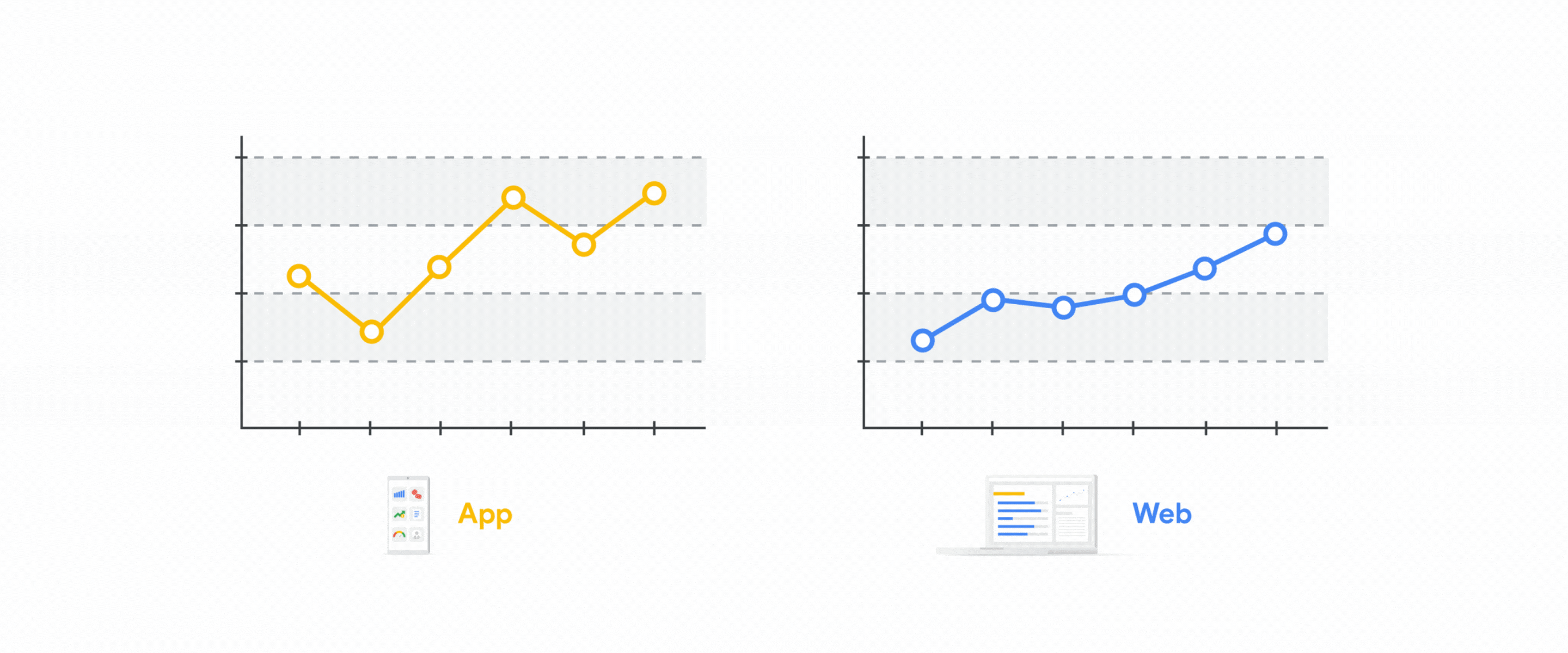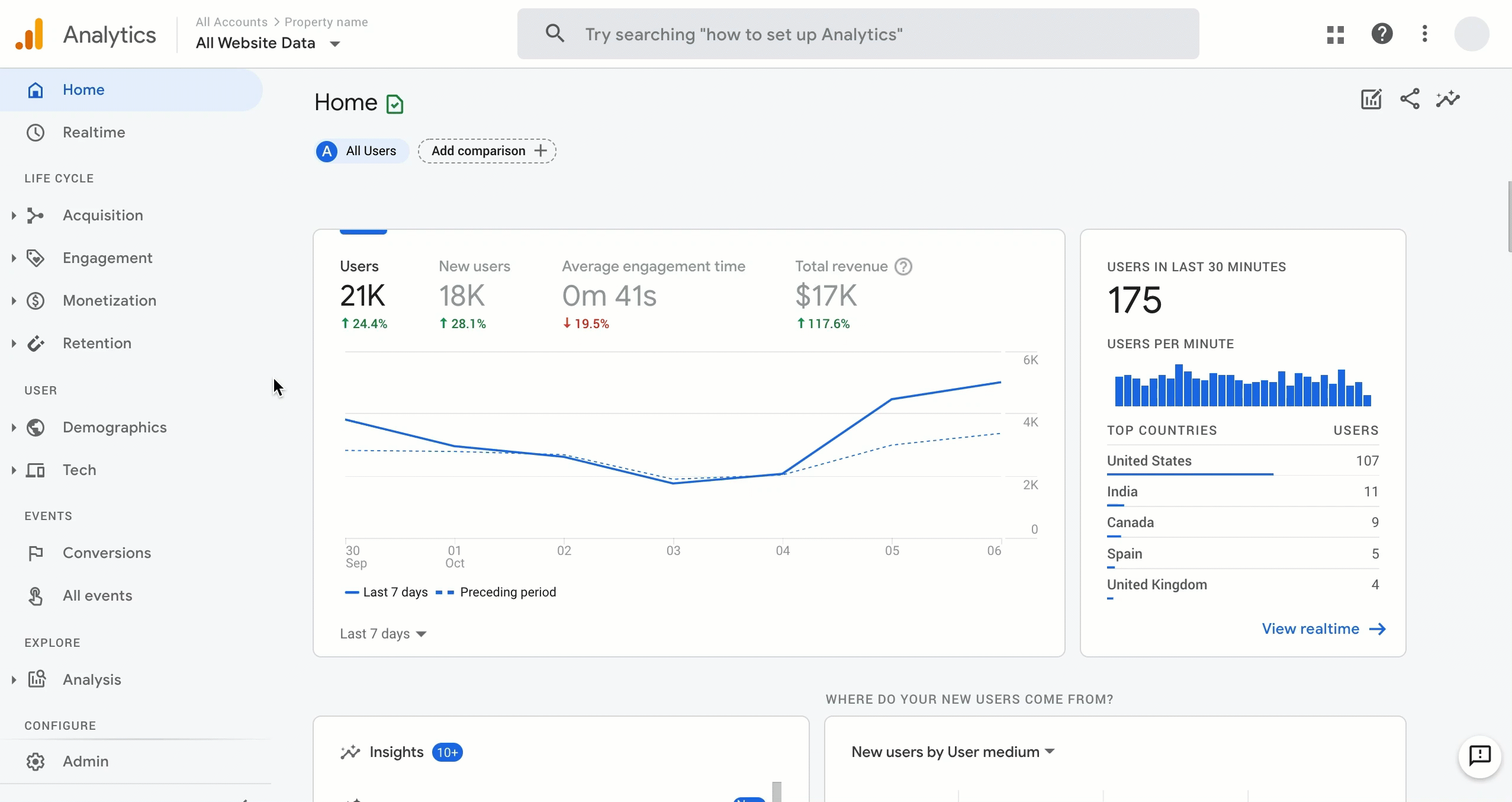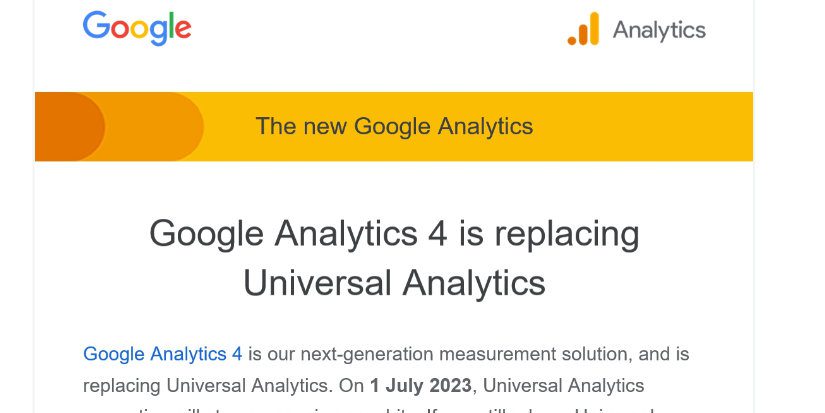Why you need to switch to Google Analytics 4 (GA4) from Google Universal Analytics (UA)
to:
-
keep track of website visitors with GA4
-
know what GA4 means for website owners
-
understand how to switch from Google UA to GA4 and
-
see why you need to get on GA4 sooner rather than later.
In October 2020, Google announced the launch of a new version of Universal Analytics (UA), dubbed GA4 (Google Analytics 4). Initially, the message to businesses was that this update is recommended. But not obligatory. People could continue using the existing UA for website analysis.
In April 2022, that messaging changed. Google began sending out notifications that GA4 would replace existing UA in July 2023.
What does this mean for businesses? Basically, if you’re still using the old Google UA platform, you need to switch to GA4 before July 2023. To avoid data disruptions and time to ensure a smooth transition, it’s better to act now than to wait.
Here’s all you need to know about the new GA4 and how to make the switch.
What is GA4 (Google Analytics 4)
GA4 is a brand new platform built from the ground up with privacy in mind. That means that it uses Google’s vast data and machine learning resources to give you more accurate insights while keeping your data safe and secure.
One of the big advantages of GA4 is that it can be used across all Google products, including Search Console, Display & Video 360, and Google Ads. This gives you a more complete picture of your customers and their journey to conversion.
Another key advantage is that GA4 allows you to track users across devices, even if they’re not logged into their Google account. This gives more accurate data on user behaviour, whether they’re on desktop, mobile or another app.

Finally, GA4 gives more control over data. You can choose how long it’s stored and who has access to it. You can also export the data at any time.
What’s new in GA4?
GA4 is not merely an upgrade of Universal Analytics. It’s a brand new way of collecting and analysing data. You can see this in several of the differences between GA4 and the old Google UA platform.
-
GA4 data model
The GA4 data model is different from the old Google UA platform because it is event-based instead of session-based. The way data is collected now is with a “data-first” approach, meaning that all data is collected before it is processed. This allows for more accurate data collection and analysis.
-
GA4 events
The update introduces a new concept called “events.” Events are user actions that can be tracked, such as button clicks or page views. Events can be used to trigger other actions, such as sending an email or showing a popup.
-
 GA4 machine learning IDs
GA4 machine learning IDs
Another key difference is the way GA4 handles user identifiers. In Universal Analytics, each user is given a unique identifier (UID) that is used to track their activity across devices and browsers. GA4 doesn’t use UIDs but instead relies on a new technology called “machine learning IDs” (MLIDs). MLIDs are designed to anonymously identify users without using personal information such as names or addresses.
Anonymously identifying users without using personal information helps to prevent spam and fake data from being collected. The dual benefit is cleaner data for businesses and protects data for consumers.
-
GA4 data limits (there are none)
Those who’ve been limited by Universal Analytics’ data limits will be delighted to learn that GA4 does not have those same data limits. It does, however, impose various limits on the number of distinct events you can track, the number of parameters per event, and the length of characters on those parameters.
-
GA4 reports
Reports in GA4 will look different than in Universal Analytics. It’s going to take some time and study to get used to. In GA4, you will be able to see more detailed information about your website traffic and how it is performing. However, many of the reports you have been familiar with in UA will not have an equivalent in GA4.
-
 GA4 privacy consent mode
GA4 privacy consent mode
GA4 offers a privacy consent mode, which gives users the ability to opt-out of data collection. This is a major change from Universal Analytics, which didn’t offer this option.
-
GA4 content groupings
The Google UA style of content groupings won’t transfer to GA4. However, it can be easily replicated on GA 4 using event parameters and custom dimensions.
-
GA4 cross-domain tracking
Notoriously challenging (and frustrating) in Google UA, cross-domain tracking in GA4 is much simpler, configured through your admin settings, without any changes to on-page tracking.
-
GA4 enhanced measurement
Where Google UA required custom GTM configuration for enhanced measurement, GA4 delivers this with little to no configuration required. It’s standard for all GA4 properties but you can disable it if you want.
What happens in July 2023
As of July 1, 2023 Google UA will no longer process or log website data. New data will only be collected in GA4’s properties.
While accounts are automatically moved over to GA4, the change will be majorly disruptive for users who are used to the Google UA interface and reports. GA4 uses a different data model than Universal Analytics, so the data that is collected will be structured differently.
Then, later in October 2023, Google Analytics 360 will also stop collecting data. After that date, GA4 will be the only Google product collecting data.
Why you need to act before 2023
If you’re still using Google UA, you need to switch to GA4 before July 2023. Google has said that they will keep historical data from UA for six months after the switch, but after that, the data will be lost.
While you have until July 2023, switching now gives you a 12-month historical window on GA4. You get ample time to migrate and understand the update before the switch is flicked and time is out.
Migrating to GA4 before July 2023 has several benefits, including:
- More accurate insights, as GA4 uses Google’s vast data and machine learning resources
- GA4 can be used across all Google products, including Search Console, Display & Video 360, and Google Ads
- Tracks users across devices, even if they’re not logged into their Google account
- More control over data, including who has access to it and how long it’s stored
- Exports data at any time
- Introduces “events,” which are user actions that can be tracked, such as button clicks or page views
- No cookies or personal information is used in GA4’s MLIDs, so you can be confident that your users’ privacy is protected and cookie blockers don’t stop visitor tracking
What’s more, GA4 is a different interface from Universal Analytics. It will take time to learn, and getting ahead of the learning curve lets you more efficiently use the tools and collected data.
How to migrate to GA4
Migrating from Google UA to GA4 is easily done in just three steps:
- Create a new property in GA4
- Migrate your data
- Update your tracking code.
Creating a new property in GA4 is easy. Just log into your Google Analytics account and click “Create Property.” Then, select “Google Analytics 4” as the property type.
Migrating your goals is a bit more complicated, but Google has created a tool to help with the process. The Google Analytics Migration Tool guides you through the process of migrating your goals from Google UA to GA4.
Once you’ve migrated your data, you need to update your tracking code. The tracking code for GA4 is different from the Google UA tracking code, so you’ll need to make sure that you’re using the correct code on your website.
Migrating with an Insight Marketing specialist
Migrating to GA4 can be a complex process if you don’t have internal specialist resources. Outsourcing can help make the process easier. While Google has done everything within its power to make it easy to transition from UA to GA4, you just need to be sure that it is all working and that the transition is going to delveir the results you need come July 2023. When you’re dealing with a tool that helps you track your online returns, you want to make sure it’s operating to full effect.
Conclusion
If you have not yet migrated to GA4, we strongly advise doing so as soon as possible. The benefits of migrating now are plentiful, as we’ve discussed above. Namely, there is a big learning curve ahead. Getting in now allows you to upskill and use the data you’re familiar with in combination with the GA4 system before you’re forced to transition completely.
If you’re not comfortable doing this yourself, call in marketing specialists (like us) to help.
If you need any more guidance or action to be taken on your migration, contact our team of specialists to discuss your migration and digital marketing needs or call on 01344 578 104.




Comments (0)